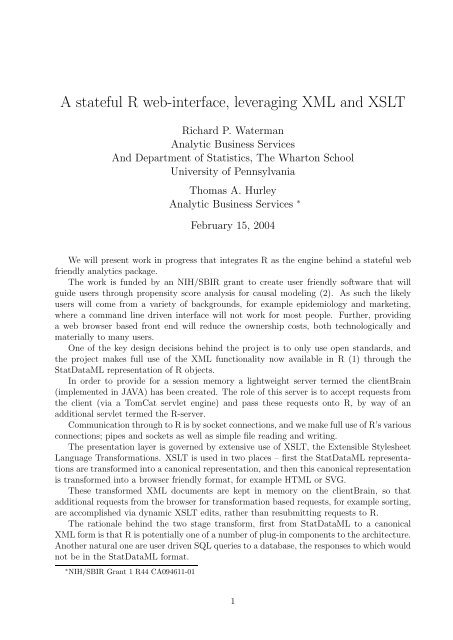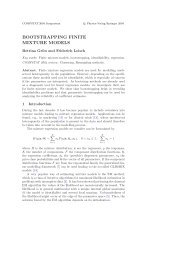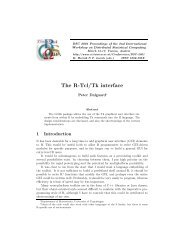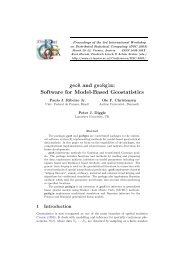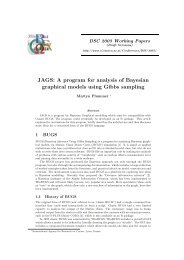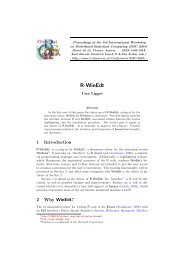Embedding R in Windows applications, and executing R remotely
Embedding R in Windows applications, and executing R remotely
Embedding R in Windows applications, and executing R remotely
Create successful ePaper yourself
Turn your PDF publications into a flip-book with our unique Google optimized e-Paper software.
A stateful R web-<strong>in</strong>terface, leverag<strong>in</strong>g XML <strong>and</strong> XSLT<br />
Richard P. Waterman<br />
Analytic Bus<strong>in</strong>ess Services<br />
And Department of Statistics, The Wharton School<br />
University of Pennsylvania<br />
Thomas A. Hurley<br />
Analytic Bus<strong>in</strong>ess Services ∗<br />
February 15, 2004<br />
We will present work <strong>in</strong> progress that <strong>in</strong>tegrates R as the eng<strong>in</strong>e beh<strong>in</strong>d a stateful web<br />
friendly analytics package.<br />
The work is funded by an NIH/SBIR grant to create user friendly software that will<br />
guide users through propensity score analysis for causal model<strong>in</strong>g (2). As such the likely<br />
users will come from a variety of backgrounds, for example epidemiology <strong>and</strong> market<strong>in</strong>g,<br />
where a comm<strong>and</strong> l<strong>in</strong>e driven <strong>in</strong>terface will not work for most people. Further, provid<strong>in</strong>g<br />
a web browser based front end will reduce the ownership costs, both technologically <strong>and</strong><br />
materially to many users.<br />
One of the key design decisions beh<strong>in</strong>d the project is to only use open st<strong>and</strong>ards, <strong>and</strong><br />
the project makes full use of the XML functionality now available <strong>in</strong> R (1) through the<br />
StatDataML representation of R objects.<br />
In order to provide for a session memory a lightweight server termed the clientBra<strong>in</strong><br />
(implemented <strong>in</strong> JAVA) has been created. The role of this server is to accept requests from<br />
the client (via a TomCat servlet eng<strong>in</strong>e) <strong>and</strong> pass these requests onto R, by way of an<br />
additional servlet termed the R-server.<br />
Communication through to R is by socket connections, <strong>and</strong> we make full use of R’s various<br />
connections; pipes <strong>and</strong> sockets as well as simple file read<strong>in</strong>g <strong>and</strong> writ<strong>in</strong>g.<br />
The presentation layer is governed by extensive use of XSLT, the Extensible Stylesheet<br />
Language Transformations. XSLT is used <strong>in</strong> two places – first the StatDataML representations<br />
are transformed <strong>in</strong>to a canonical representation, <strong>and</strong> then this canonical representation<br />
is transformed <strong>in</strong>to a browser friendly format, for example HTML or SVG.<br />
These transformed XML documents are kept <strong>in</strong> memory on the clientBra<strong>in</strong>, so that<br />
additional requests from the browser for transformation based requests, for example sort<strong>in</strong>g,<br />
are accomplished via dynamic XSLT edits, rather than resubmitt<strong>in</strong>g requests to R.<br />
The rationale beh<strong>in</strong>d the two stage transform, first from StatDataML to a canonical<br />
XML form is that R is potentially one of a number of plug-<strong>in</strong> components to the architecture.<br />
Another natural one are user driven SQL queries to a database, the responses to which would<br />
not be <strong>in</strong> the StatDataML format.<br />
∗ NIH/SBIR Grant 1 R44 CA094611-01<br />
1


